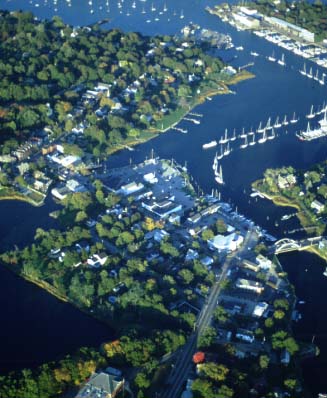Wickford, Rhode Island facts for kids
Quick facts for kids |
|
|
Wickford Historic District
|
|

Wickford from the air, looking east.
|
|
| Location | North Kingstown, Rhode Island |
|---|---|
| Area | 380 acres (150 ha) |
| Architect | Tefft, T.A.; Sawtelle, W.C. |
| Architectural style | Greek Revival, Late Victorian, Federal |
| NRHP reference No. | 74000013 |
| Added to NRHP | December 31, 1974 |
Wickford is a charming village located in North Kingstown, Rhode Island. It's named after a town called Wickford in England. This historic village sits on the western side of Narragansett Bay, which is a large inlet of the Atlantic Ocean. You can reach Wickford from Newport, Rhode Island by driving about 20 minutes across two bridges.
Wickford is special because it has a very safe natural harbor, which is a great place for boats. It also has one of the biggest collections of homes built in the 1700s anywhere in the northeastern United States. Many of these old homes and buildings are still standing today, looking much like they did centuries ago.
Contents
The Story of Wickford
Early Days and First Settlers
Wickford's story began around 1637. That's when Roger Williams, who helped start the state of Rhode Island, bought land from a Native American leader named Canonicus. Williams then set up a trading post there. Before Europeans arrived, the Narragansett tribe lived in and around Wickford. They used the land for homes, fishing, and hunting. The Narragansett were a powerful tribe in New England at that time.
Around the same time, a man named Richard Smith also started a trading post. It was near where the Cocumscussoc Brook meets Narragansett Bay. Smith was from England and had first settled in another colony. In 1637, he built a large house that Roger Williams described as the first English house in the area. This house was very strong and became known as Smith's Castle.

Smith's Castle and King Philip's War
In 1651, Richard Smith bought Roger Williams' trading post. He kept buying more land, creating a large area called the Cocumscussoc Plantation. This plantation became an important place for social, religious, and political life in the region.
During a conflict known as King Philip's War, many homes built in Wickford were destroyed. Smith's Castle was burned down in 1676. However, just two years later, Richard Smith Jr. built a new house on the same foundation. He kept the name "Smith's Castle." This building is still standing today and is a popular historic site to visit.
Growth and the American Revolution
After King Philip's War, Wickford grew steadily. It became an important port and a place where ships were built. Even today, the waterfront is still very busy.
Captain Lodowick Updike helped develop much of the early village between 1709 and 1715. He inherited the land from his uncle, Richard Smith. The village was sometimes called "Updike's New Town" or "Wickford." The name "Wickford" honored the English hometown of the wife of Connecticut's Governor John Winthrop.
In 1707, the Old Narragansett Church was founded in downtown Wickford. It is the oldest Episcopal church building in the northeastern United States.
During the American Revolution, in 1776, the British military tried to attack Wickford. But the town used a special cannon, called the "Wickford gun," to stop them. This cannon had been given to the town by the government for defense. Later, the gun was moved to Point Judith. There, it was used to make a British ship surrender its crew. The captured prisoners were then taken to Providence.
Famous People Connected to Wickford
Many interesting people have lived in or had ties to Wickford.
- The famous painter Gilbert Stuart was born in 1755 in a nearby village called Saunderstown. His birthplace, an old mill, is now open to the public.
- Novelist Owen Wister spent many summers in a home just south of the village.
- Paule Stetson Loring, an artist for Yachting magazine and other publications, also lived in Wickford. He was a longtime cartoonist for The Providence Journal newspaper.
- There's a popular story that novelist John Updike was from Wickford, but that's not true. He was born in Pennsylvania. However, Updike did use Wickford as the inspiration for the fictional village of Eastwick in his book, The Witches of Eastwick.
- A branch of the Updike family was among the first families to settle in Wickford. In fact, the original village was once called Updike's Newtown.
- Christian leader Joshua V. Himes grew up in Wickford.
Other Notable People
- Frances Irene Burge Griswold, a writer.
- Louis Sauzedde, a shipbuilder.
Wickford Art Festival
Every July since 1962, Wickford hosts the Wickford Art Festival. This event is put on by the Wickford Art Association. It's one of the most important art festivals on the eastern coast of the United States. Hundreds of talented artists and thousands of visitors from all over the country and the world come to enjoy it.



